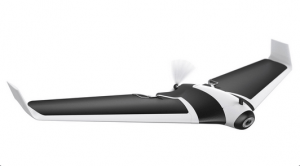
Launch it by throwing it in the air, and watch it reach 50mph before landing automatically.
Somewhere between the enthusiast’s gasoline-powered scale model of a Cessna 172 and the Reaper and Predator drones that fly secret kill missions for the Obama administration, there’s an untapped middle ground of consumer-friendly, fixed-wing unmanned aerial vehicles.
Drone maker Parrot took its first step onto that ground today by announcing the commercial availability of the Disco, which it describes as the first fixed-wing consumer drone. Unveiled at CES in January, the 50mph machine has a battery life of 45 minutes, as well as all the autopilot, GPS, and other easy-to-use features you’d expect from Parrot. Its $1,299 sticker price, though, is significantly higher than that of most Parrot drones.
For that price, you also get Parrot’s new remote control, as well as a virtual-reality-like headset that can stream footage from the drone’s included Full HD camera, enabling Disco pilots to fly as if they were in the air themselves. The headset works much the same way as a Google Cardboard-based device: you insert a smartphone into the slot to view the live streaming video. Radar and telemetry data are also displayed, giving you a heightened sense of being in the cockpit.
The Disco also offers automatic takeoff and landing. After engaging takeoff mode on the remote control, you simply throw the drone into the air, after which it will ascend to an altitude of about 160 feet and start flying circles while it awaits further instruction.
Landing mode appears to be equally easy. Once engaged, the Disco will descend to just below 19 feet before reversing the thrust from its motor to slow as much as possible for a smooth touchdown.
The Disco incorporates other technology that has long been used in full-size aircraft, including pitot tubes that let it measure airspeed and an inertial navigation system comprising an accelerometer, gyroscope, magnetometer, and altimeter. As with other drones, it can also automatically return to a pre-set “home” location using GPS signals.
Parrot, which is best known for inexpensive quadcopters that are flown at moderate altitude and speed, is venturing into relatively uncharted airspace with the Disco. In a nod to model aircraft enthusiasts, it will sell an adapter that allows the Disco to be manually flown using the RC controllers with which they’re familiar. But as with many other innovative drones that manufacturers have touted this year, from the auto-follow Lily to a flying Hasselblad, Parrot will have to convince people who previously never thought they needed—or wanted—a drone to buy a Disco.
Still, a 50mph fixed-wing airplane that requires no tinkering or fuel and can be piloted using VR glasses seems to be a pretty good deal for $1,299.

